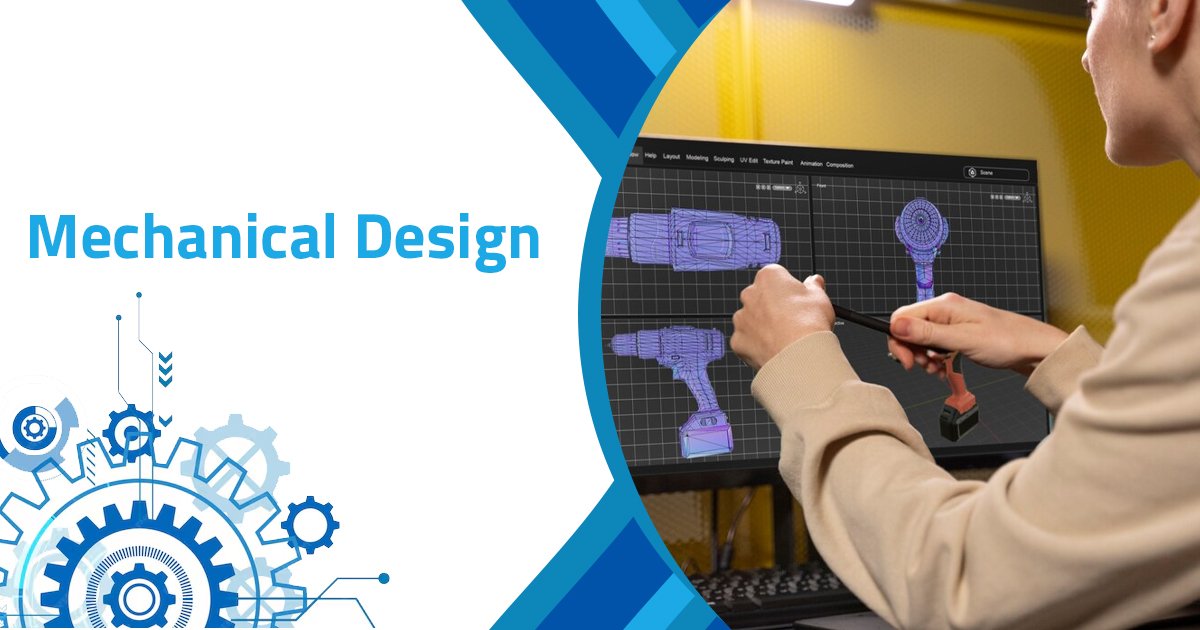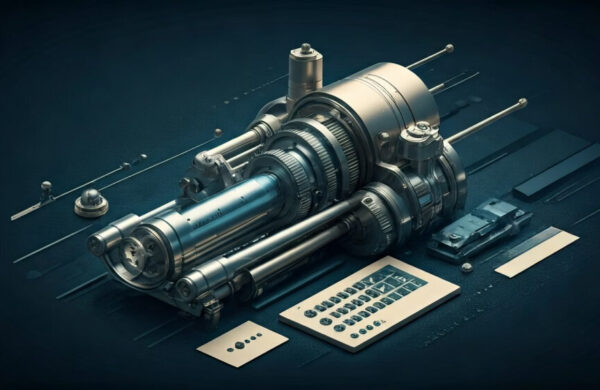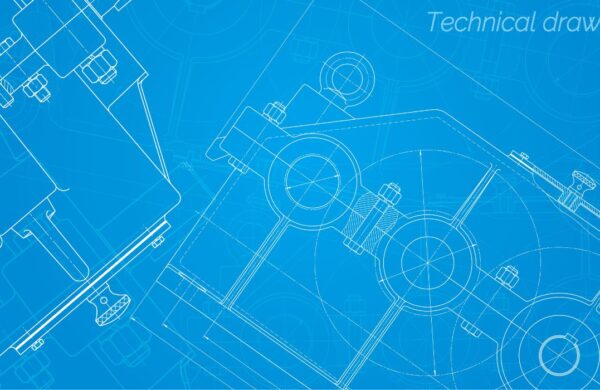In the vast engineering landscape, mechanical design stands as a formidable pillar, dictating the trajectory of technological advancement across various industries. From conceptualization to realisation, the principles of mechanical design permeate every facet of product development, ensuring efficiency, reliability, and innovation. In this blog, we will be Investigating the fundamental principles, delineating the responsibilities of mechanical designers and engineers, examining the technological progressions propelling the industry, and elucidating the essential tools and skills pivotal for achieving success.
What is Mechanical Design?
Mechanical design is a crucial aspect of mechanical engineering services. Mechanical design is more than just the application of technical knowledge; it’s an art form that blends creativity with precision. At its core, this design involves translating conceptual ideas into tangible solutions, whether it’s designing cutting-edge automotive engines or optimizing manufacturing processes. This marriage of innovation and meticulous planning forms the bedrock of modern engineering.
Mechanical design encompasses a wide array of disciplines, from structural analysis and thermodynamics to fluid mechanics and materials science. By leveraging scientific principles and engineering methodologies, mechanical designers and engineers can develop innovative engineering solutions to complex problems, driving progress and innovation across diverse industries.
Mechanical Designers vs. Mechanical Engineers
In the realm of this mechanical design, two primary roles emerge: mechanical designers and mechanical engineers. While their responsibilities may overlap, each role brings a unique set of skills and expertise to the table. Below are the differences between them.
Duties:
- Mechanical engineers are primarily tasked with conceptualising, designing, and overseeing the entire lifecycle of mechanical systems. This involves feasibility studies, conceptualization, design, testing, and overseeing manufacturing processes.
- In contrast, mechanical designers, often referred to as drafters, concentrate on translating conceptual sketches and ideas provided by mechanical engineers into detailed technical plans and digital models using CAD software. Their focus lies in the meticulous creation of these plans, ensuring accuracy and adherence to engineering specifications.
Education Requirements:
- Mechanical engineers typically pursue higher education, often holding bachelor’s or master’s degrees in mechanical engineering or related disciplines. These programs equip them with the necessary theoretical knowledge and practical skills required for engineering roles.
- On the other hand, mechanical designers may have varied educational backgrounds. While some may have formal education in drafting or design, others may acquire proficiency in CAD software through specialised training programs or vocational courses.
Salary:
- Due to their advanced education and broader responsibilities, mechanical engineers generally command higher salaries compared to mechanical designers. This salary difference reflects the higher level of expertise and responsibility associated with engineering roles.
Skills:
- Mechanical engineers require a diverse skill set, including strong analytical and technical abilities, proficiency in CAD software, and in-depth knowledge of mathematics and physics. They must also possess the ability to consider broader factors such as manufacturing costs and environmental impact.
- Conversely, mechanical designers must excel in CAD software and demonstrate creativity and artistic skills. Additionally, effective communication and collaboration skills are essential as they often work closely with engineers and other team members to refine designs and ensure alignment with project requirements.

Difference Between Mechanical Designers and Mechanical Engineers
The Evolution of Mechanical Design Technology
Advancements in technology have revolutionised the field of mechanical design, enabling designers and engineers to create more sophisticated and efficient products. CAD software, such as Dassault Systèmes’ CATIA suite, has become an essential tool for mechanical designers and engineers alike. This software allows users to create detailed 2D and 3D models, simulate real-world conditions, and analyse the performance of mechanical systems.
Cloud-based solutions, such as SOLIDWORKS Cloud Offer, have further democratised access to advanced design tools. These platforms allow designers and engineers to collaborate remotely, share files in real time, and access powerful computing resources from anywhere in the world. The integration of cloud technology has accelerated the pace of innovation in this design, allowing teams to iterate quickly and bring products to market faster.
Practical Applications of Mechanical Design
The applications of mechanical design are vast and varied, spanning industries such as automotive, aerospace, manufacturing, and healthcare. In the automotive industry, this design plays a critical role in the development of vehicles, from engine components to chassis design. Aerospace engineers rely on mechanical design principles to design aircraft, spacecraft, and propulsion systems that can withstand extreme conditions.
In manufacturing, this design is essential for optimizing production processes and improving efficiency. Mechanical designers work closely with production engineers to develop equipment and machinery that can automate tasks, increase productivity, and reduce costs. In the healthcare industry, this design is used to develop medical devices, prosthetics, and surgical instruments that improve patient outcomes and quality of life.
The Qualities of Successful Mechanical Designers and Engineers: Beyond Technical Proficiency
While technical proficiency is crucial in mechanical design, successful designers and engineers possess a range of skills and qualities that set them apart. Creativity, problem-solving ability, and attention to detail are essential traits that enable designers to innovate and develop novel solutions to complex problems.
Effective communication and collaboration skills are also vital for success in mechanical design. Designers and engineers must be able to communicate their ideas clearly and collaborate with colleagues from diverse backgrounds and disciplines. Strong project management skills are also essential for coordinating tasks, meeting deadlines, and delivering projects on time and within budget.
Conclusion
Whether you’re a mechanical engineer or a designer, the opportunities for growth and impact are boundless. By embracing the latest technologies and fostering collaboration, individuals can contribute significantly to the advancement of mechanical design services. Companies like Monarch Innovation. exemplify this commitment to excellence, driving innovation and inspiring future generations of engineers and designers. Contact us our mechanical designer and engineering expert today.
FAQs
Q: What is the difference between a Mechanical designer and an Engineer?
A: A mechanical designer primarily focuses on creating detailed drawings, schematics, and blueprints using computer-aided design (CAD) software. They work closely with engineers to translate conceptual designs into technical plans. Engineers, on the other hand, apply scientific principles to solve technical problems and ensure the functionality, safety, and efficiency of designs. They often oversee the design process and are responsible for making critical engineering decisions.
Q: What do Mechanical Designers do?
A: Mechanical Designers focus on creating detailed designs, drawings, and models of mechanical components using CAD software based on engineering specifications.
Q: What industries utilize Mechanical Design expertise?
A: Industries such as automotive, aerospace, manufacturing, robotics, consumer electronics, and renewable energy rely heavily on Mechanical Design for product development and innovation.
Q: What is 3D mechanical design?
A: 3D mechanical design involves creating digital models of mechanical components or products. Three-dimensional modelling allows engineers to visualize and simulate their designs before construction. A detailed analysis, precise measurements, and virtual testing are enabled by this approach.
Q: What software is commonly used for 3D mechanical design?
A: Some popular software tools for 3D mechanical design include SolidWorks, Autodesk Inventor, CATIA, Creo Parametric, and Solid Edge. These programs offer a range of features for creating, modifying, and analyzing 3D models, as well as generating detailed drawings and documentation.





